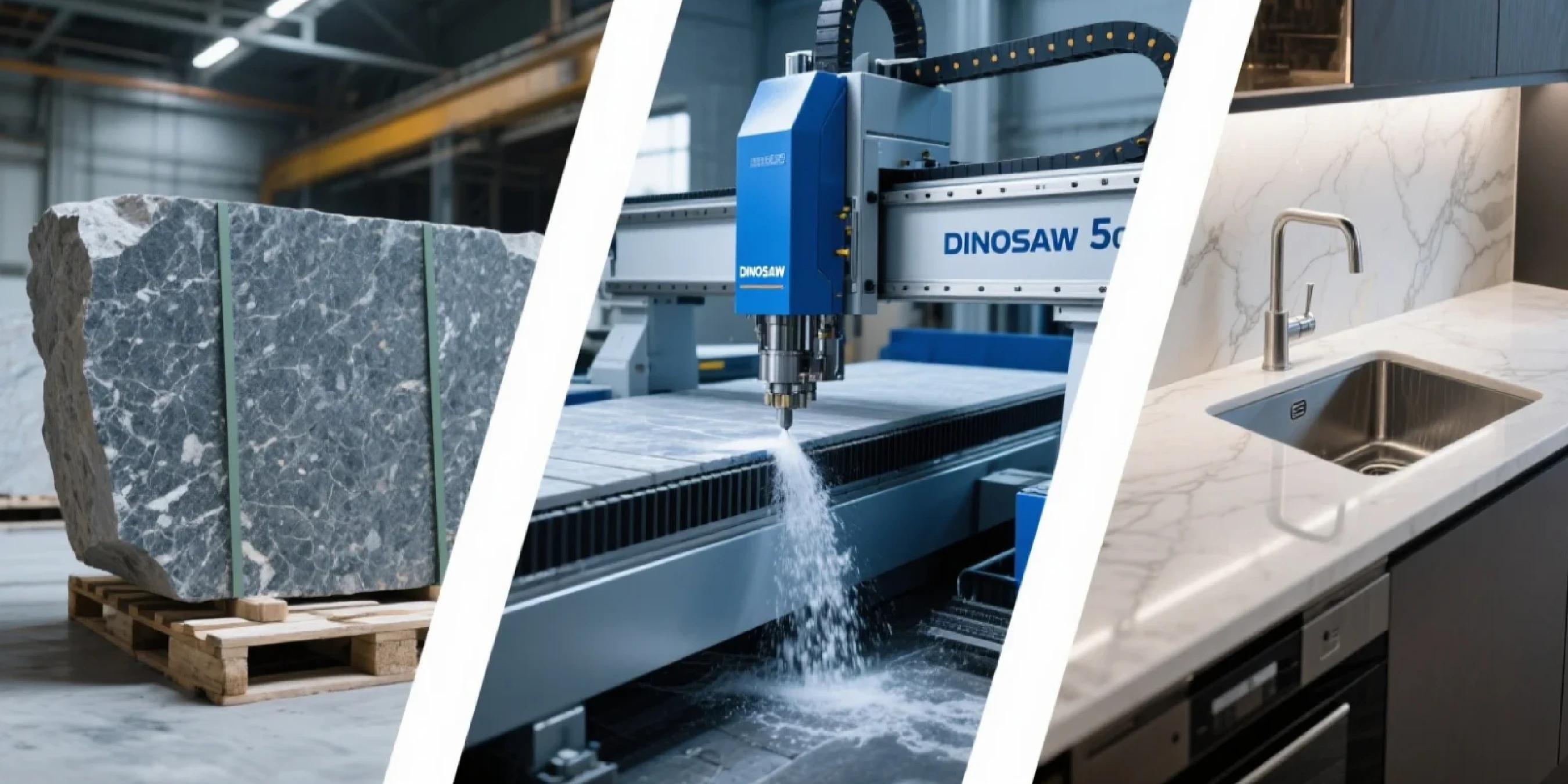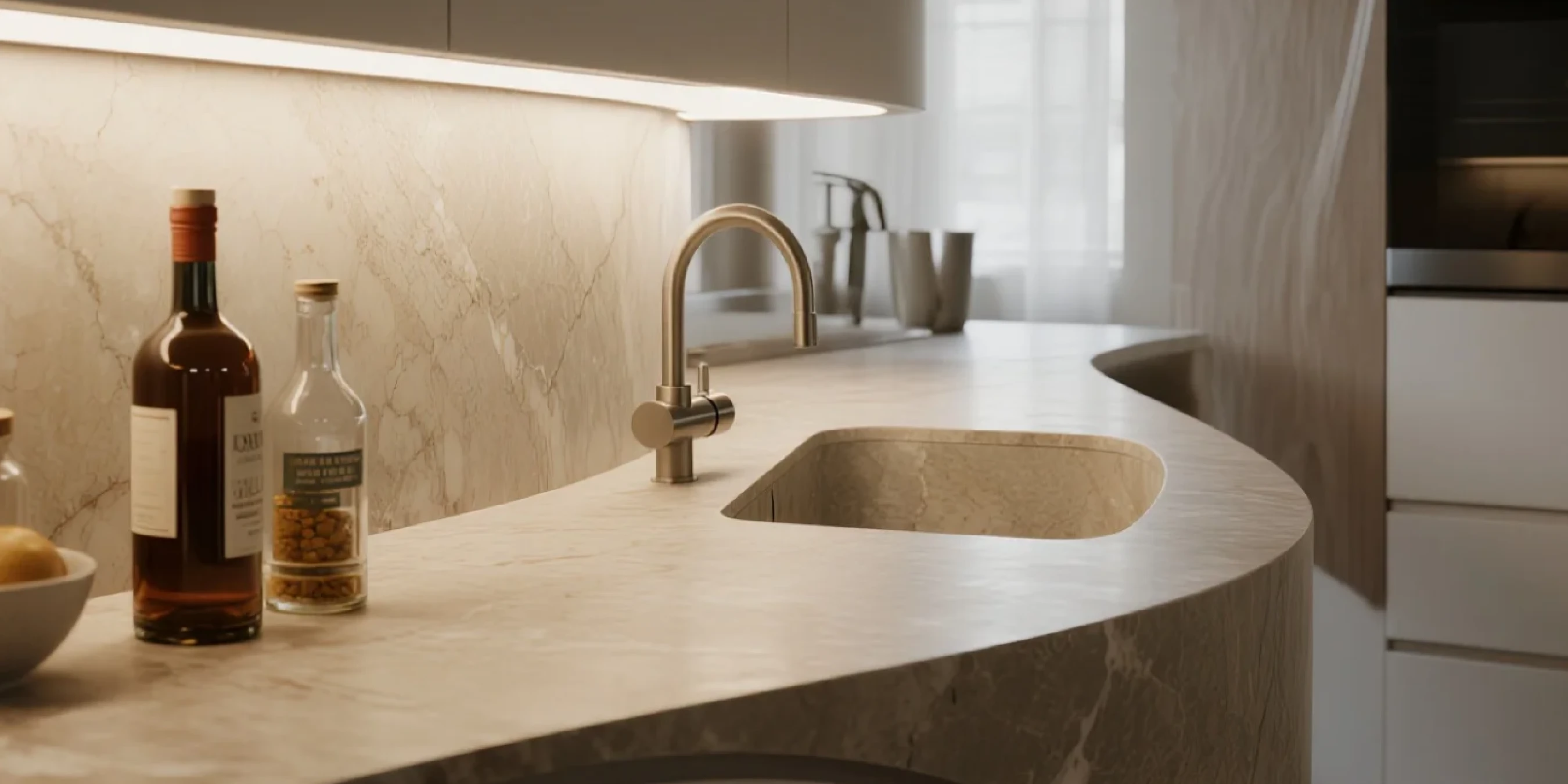Hi, this is Lizzy from Dinosaw ( Not a Robot ). Which Machine ( model ) do you want? Please WhatsApp us now
Step‑by‑step workflow for granite, marble and quartz. Digital templating, vacuum pods, finger bits and core drills, beveled edges, 15–25‑min cycles and ROI basics to cut clean, fast.
Sink cut-outs represent the make-or-break moment in nearly every countertop project. Yet most fabrication shops treat them as a necessary evil—a time-consuming bottleneck that eats into profits and limits growth potential.
Here's the reality: relying on manual methods doesn't just slow you down. It actively sabotages your bottom line while competitors with CNC technology capture the high-margin custom work you're forced to turn away.
This guide cuts through the technical jargon to deliver a business-focused playbook for CNC sink cut-outs. We'll show you exactly how to calculate ROI, choose the right equipment, and build a workflow that turns every cut into consistent profit.

Why Manual Sink Cutting Is Bleeding Your Profits
Every hour spent grinding sink holes by hand represents money walking out your door. The hidden costs stack up faster than most shop owners realize.
The Real Cost of "Cheap" Manual Methods
Direct labor costs hit you first. A skilled fabricator burns 1-3 hours on a single sink cut-out. According to U.S. Bureau of Labor Statistics - Occupational Outlook Handbook , skilled machinists represent a significant and rising expense that impacts your competitive position.
But labor is just the beginning. One slip of the grinder can destroy a $3,000 slab instantly. Material waste from human error adds up to thousands in losses per month for busy shops.
The Opportunity Cost: Missing Out on Premium Projects
The biggest cost? The jobs you can't take. Modern design trends favor integrated sinks, complex curves, and custom profiles that manual methods simply cannot execute with the required precision.
While you're stuck with basic rectangular cuts, competitors with 5-axis CNC capabilities are capturing premium clients who pay 40-60% more for custom work.
Performance Data: Manual vs. CNC Reality Check
| Metric | Manual Cut-Out | CNC Cut-Out (5-Axis Bridge Saw) | Advantage |
|---|---|---|---|
| Average Time | 60-120 minutes | 15-25 minutes | 75-80% Time Reduction |
| Material Risk | High (human error) | Low (±0.05mm precision) | Minimized Waste |
| Labor Skill | Requires senior fabricator | Trained operator sufficient | Optimized Workforce |
| Job Complexity | Basic shapes only | Any shape, integrated sinks | Premium Market Access |
3-Axis vs. 5-Axis: Choosing Your CNC Strategy
Not all CNC bridge saws deliver the same competitive advantage. Your choice between 3-axis and 5-axis technology will define your shop's capabilities for years to come.
3-Axis CNC: The Reliable Workhorse
A 3-axis CNC bridge saw operates on X, Y, and Z movements—left-right, front-back, and up-down. This setup handles standard rectangular and circular sink cuts with excellent efficiency.
For shops focused on high-volume standard countertops, a 3-axis machine delivers solid ROI through dramatically faster cycle times and consistent quality.
5-Axis CNC: The Market Differentiator
A 5-axis CNC adds rotational movement to the cutting head, enabling it to tilt and rotate.
Beyond cutting the hole, a 5-axis machine creates beveled edges for undermount sinks, drills angled faucet holes, and mills drainage grooves—all in one automated setup. This level of integration is what separates premium fabricators from commodity shops.
Technical Advantages: Speed Meets Precision
The real power of 5-axis technology lies in workflow consolidation. By combining cutting, drilling, and profiling operations, you eliminate slab handling between workstations. This reduces damage risk and slashes total cycle time.
The DINOSAW 5-Axis CNC Bridge Saw for Sinks & Countertops exemplifies this all-in-one approach. For balanced capability and value, the 4+1 Axis Bridge Saw | CNC Stone Cutting Machine offers integrated milling functions that provide significant competitive advantages. Understanding these machines requires exploring the Anatomy of a CNC Bridge Saw: An Expert's 2025 Guide , which breaks down every critical component.

The 5-Step CNC Workflow: From Design to Perfect Finish
Maximizing your CNC investment requires a systematized workflow. This 5-step process ensures consistent results regardless of material or complexity.
Step 1: Digital Templating & CAD/CAM Programming
The process begins with a digital template—typically a DXF file from the sink manufacturer. Import this into your CAD/CAM software, position it on the virtual slab, and define toolpaths for cutting plus any additional operations like faucet holes or edge profiling.
Step 2: Machine Setup & Tool Selection
Secure the stone slab on the machine's worktable using vacuum pods or clamps. Load the appropriate tooling—finger bits for cutting, core drills for holes—into the tool holder. Proper tool selection depends on material hardness, which you can reference against Natural Stone Institute (NSI) - Material Technical Data Sheets .
Step 3: Optimized Cutting for Different Stone Types
Load the program and initiate the cutting cycle. The machine executes pre-programmed toolpaths automatically. Success depends on optimizing spindle speed (RPM) and feed rate for each material—settings that vary dramatically between hard quartzite and softer marble.
Step 4: Automated Faucet & Fixture Drilling
For programs including faucet holes, the machine automatically switches to core drill bits after completing the main cut-out. It precisely drills holes at specified locations, ensuring perfect alignment every time.
Step 5: Integrated Edge Profiling
With 5-axis capabilities, edge profiling happens automatically. The machine uses profiling tools to create beveled, bullnose, or custom edge profiles around the sink cut-out. Advanced systems can even perform initial polishing, dramatically reducing manual finishing time.

ROI Calculator: How Fast Your CNC Pays for Itself
CNC investment isn't an expense—it's a profit accelerator. The question isn't whether you can afford it, but how quickly it transforms your bottom line.
Simple Breakeven Formula
Calculate your breakeven point with this straightforward equation:
(Machine Investment) ÷ [(Revenue per Sink) - (Variable Costs per Sink)] = Sinks to Break Even
- Machine Investment: Your total CNC system cost
- Revenue per Sink: What you charge for sink cut-outs
- Variable Costs: Operator time, tooling wear, electricity
By reducing cut-out time from 2 hours to 20 minutes, a single operator can produce 20+ automated cut-outs daily versus 4 manual ones. This 5x throughput increase means rapid payback periods for most busy shops.
Want a personalized ROI calculation for your shop? Chat with our CNC expert on WhatsApp now!
Premium Revenue Streams: Where Real Profits Hide
The 5-axis CNC advantage extends far beyond faster standard cuts. You gain access to high-margin custom work that manual methods cannot execute.
As the Stone World 2024 State of the Industry Report confirms, demand for custom and luxury stone work drives primary market growth. Integrated marble sinks, curved countertops, and intricate designs all command premium prices—and all were previously beyond reach.
Long-Term Value: Building a Scalable Business
Automated sink cutting frees your most skilled fabricators for high-value finishing and quality control. This makes your business more resilient to labor shortages while enabling production scaling without proportional headcount increases.

Troubleshooting: Mastering Common CNC Challenges
Even advanced automation requires expertise to achieve consistent perfection. Here's how to address the most common issues.
Preventing Chipping on Delicate Materials
Chipping destroys profits faster than any other fabrication issue. Primary causes include incorrect feed rates, worn tooling, or excessive vibration.
Combat this with multi-step cutting—a roughing pass followed by finishing. Keep tools sharp, reduce feed rates on fragile stones, and ensure proper machine calibration. For detailed analysis, review our guide on What Causes Chipping in Granite & Quartzite?
Perfect Inside Corners Without Over-cutting
Clean inside corners on rectangular sinks distinguish quality craftsmanship. Achieve this through CAM software programming with small radius or "dog-bone" corner toolpaths. This allows round finger bits to clear corners completely without over-cutting visible edges.
Tool Wear Management for Consistent Performance
Diamond tooling represents a significant consumable cost. Track linear feet or cut-out count per tool. Implement regular inspection schedules and replacement protocols. High-quality tools operated within recommended parameters deliver dramatically extended life and consistent cut quality.

Transform Your Shop: The Path to Automated Profitability
Mastering CNC sink cut-outs represents more than technical advancement—it's fundamental business transformation. By replacing slow, error-prone manual processes with fast, precise automation, you simultaneously reduce costs, eliminate waste, and access higher-margin projects.
A 5-axis CNC bridge saw isn't just equipment—it's a growth catalyst that enables capacity increases, workforce optimization, and market dominance in modern stone fabrication.
Ready to eliminate bottlenecks and boost profits? Click here to discuss your sink cutting needs with a DINOSAW specialist on WhatsApp.
Frequently Asked Questions (FAQs)
How long does a CNC machine take to cut a sink hole in granite?
A CNC machine completes a standard granite sink hole in approximately 15-25 minutes. This represents a 75-80% time reduction compared to manual methods requiring 1-2 hours. Exact timing depends on granite thickness, hardness, cut-out complexity, and specific tooling. A DINOSAW 5-axis bridge saw optimizes this process by combining cutting and faucet drilling in one automated cycle.
What is the best tool for cutting a sink hole in quartz countertops?
The optimal tool is a high-quality diamond finger bit specifically designed for engineered stone. Quartz cutting requires tools that provide clean, fast cuts while minimizing chipping risk. For faucet holes, use diamond core drill bits. DINOSAW recommends tools with optimized diamond segments and center water feed systems for adequate cooling, preventing thermal shock and extending tool life.
Can a 3-axis CNC cut out a sink?
Yes, a 3-axis CNC bridge saw efficiently cuts standard sink shapes including rectangles and circles. It operates on X, Y, and Z axes for vertical cuts. However, it cannot perform angled cuts or complex profiling like sloped drainboards or beveled edges for undermount sinks in single setups. These tasks require manual intervention or advanced 5-axis machines.
How does a 5-axis CNC prevent chipping when cutting sink holes?
A 5-axis CNC prevents chipping through multiple mechanisms: absolute precision, optimized toolpaths, and superior tooling integration. Rigid construction minimizes vibration—a primary chipping cause. CAM software enables sophisticated toolpaths like "ramping" into material instead of vertical plunging, reducing stone stress. Additionally, 5-axis machines can use profiling tools at slight angles to create chamfered or beveled edges, which resist chipping better than sharp 90-degree edges.
What is the typical ROI for a CNC sink cutting machine?
Typical ROI for CNC machines in busy fabrication shops ranges from 12-24 months. This is achieved through significantly reduced labor costs per countertop, minimized material waste from errors, and increased production capacity. The ability to accept high-margin, complex jobs previously impossible further accelerates return on investment. Shops producing just a few countertops daily can see immediate profitability gains by automating this critical process.

























 English
English 中文
中文 Italian
Italian Türkçe
Türkçe Português
Português

